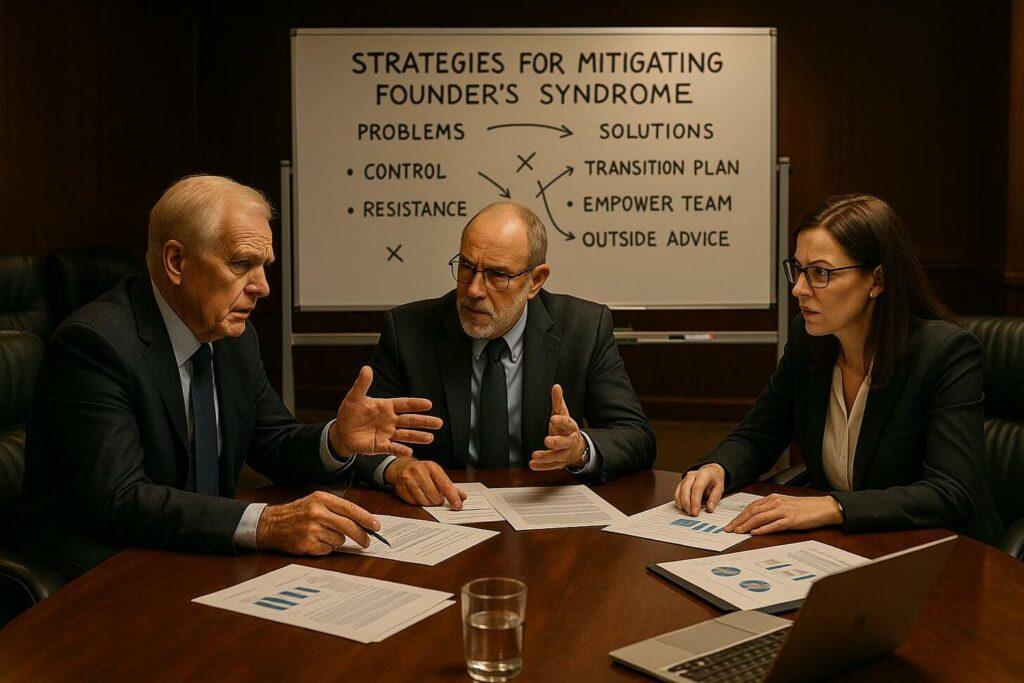Imagine building something great, only to see it stall because one person can’t let go. That’s the concept behind the founder’s syndrome mental model. It happens when the person who started an organization holds too much control, even as the group grows. Decisions pile up, progress slows, and teams feel stuck waiting for approval.
This pattern isn’t just about ego. Founders often have deep emotional ties to their work. They might resist new ideas or hesitate to delegate, fearing their vision or integrity could be compromised. Over time, this creates bottlenecks. Teams split into factions—some fiercely loyal, others pushing for change.
Why does this matter? Whether it’s a nonprofit or a tech startup, growth demands adaptability. A founder’s reluctance to share power can clash with emerging leaders. For example, a board might struggle to modernize processes if every choice needs the founder’s nod. Sound familiar? Research shows this syndrome undermines governance and long-term success.
In this article, we’ll explore how over-control stifles innovation and what healthy leadership transitions look like. Have you seen these challenges in your work?
Key Takeaways
- Occurs when a leader’s tight control limits organizational growth.
- Common signs include slow decision-making and resistance to new leadership.
- Emotional attachment to the mission often fuels this behavior.
- Both nonprofits and businesses face risks if power isn’t shared.
- Strong governance and delegation are key to avoiding stagnation.
Introduction to The Founder’s Syndrome Mental Model

Picture a thriving startup where every decision hinges on a single person’s approval. This scenario captures the essence of what happens when leadership becomes overly centralized. At its core, this pattern emerges when early choices made by one individual shape an organization’s direction so deeply that adapting becomes difficult.
Understanding the Concept
Many teams naturally view their founder as the heart of their mission. Their original vision often defines the group’s identity—like a nonprofit that ties its brand to its creator’s personal story.
But over time, this loyalty can create rigid structures, a hallmark of founder syndrome. New members might hesitate to suggest changes, fearing they’ll clash with the established approach and the founder’s influence.
Why It Matters in Today’s Organizations
Modern business environments demand flexibility. When a leader’s style resists fresh perspectives, innovation stalls. A 2022 study found 63% of social enterprises struggle to scale due to over-reliance on founders. Does your team feel trapped between honoring tradition and pursuing growth?
This article explores how balancing ownership with collaborative work unlocks potential. We’ll share real-world examples and practical steps to foster a shared vision—without losing what makes your organization unique.
Historical Overview and Origins

In the 1980s, nonprofit leaders noticed a troubling pattern. Organizations that started strong often plateaued when their creators refused to adapt. This led experts to name the issue “founder syndrome.” Early cases showed founders clinging to control even as their groups outgrew solo leadership.
The Birth of the Concept
One famous example comes from the Smithsonian Institution. In the 2000s, its secretary resisted board oversight despite financial mismanagement claims. This clash highlighted how founders could prioritize personal vision over institutional integrity. Similar stories emerged in tech startups, where early leaders blocked investor-backed scaling plans, reflecting the common symptoms founder syndrome that many organizations face.
Founder’s Syndrome Mental Model: Evolution Over Time
By the 2010s, studies revealed founder syndrome in 41% of struggling nonprofits. Boards began adopting term limits and clearer governance roles. Today, companies like Basecamp use rotating leadership teams to prevent power hoarding. Startups now often hire “scale-up CEOs” once they reach 50 employees.
| Time Period | Key Change | Impact |
|---|---|---|
| 1980s-1990s | Term coined in nonprofit sector | Raised awareness of leadership bottlenecks |
| 2000s | Corporate governance reforms | Boards gained more oversight power |
| 2020s | Tech industry adaptations | Founders exit earlier in growth cycles |
Does your organization face similar growing pains? Many teams now balance respect for founders with structured leadership transitions. How has your company handled these changes?
Defining Characteristics and Symptoms

Have you ever watched a team wait weeks for a simple decision? This delay often points to a deeper issue. When leaders cling too tightly to control, entire organizations feel the strain.
Over-Control and Resistance to Change
A founder might insist on approving every detail—from budgets to blog posts. Research shows teams in these environments make decisions 40% slower than average. One tech startup’s product launch stalled for months because the CEO redesigned the logo six times.
This behavior creates factions. Some team members defend the status quo, while others push for new approaches. Over time, this divide weakens trust and collaboration.
Emotional Attachment and Lack of Delegation
Many founders see their company as an extension of themselves. A survey of 500 growing businesses found 58% of leaders struggle to delegate tasks tied to their original vision. They fear others might dilute the mission’s integrity.
This emotional bond leads to bottlenecks. Marketing teams can’t launch campaigns without approval. HR delays hiring critical roles. Progress depends entirely on one person’s availability.
Key signs to watch for:
- Repeatedly overriding team choices
- Micromanaging routine tasks
- Delaying promotions for emerging leaders
- Viewing suggestions as personal criticism
Does your group face similar roadblocks? A nonprofit once lost three directors in a year because its founder revised every grant proposal. Recognizing these patterns early helps teams course-correct before stagnation sets in.
The Founder’s Syndrome Mental Model in Action

What happens when a leader can’t share control? Real-world stories show how tight grip on power creates ripple effects. Let’s explore how this plays out across different sectors.
Real-World Leadership Challenges
The Smithsonian Institution faced turmoil when its longtime leader refused board input. Despite financial concerns, he viewed oversight as a threat to his vision. This clash, a classic example of founder syndrome, stalled key projects for years.
In the nonprofit world, the Three Cups of Tea scandal revealed similar patterns. The founder’s reluctance to accept accountability led to donor lawsuits. His emotional tie to the organization mission blinded him to governance gaps, highlighting the impact of his leadership style.
Impact on Nonprofit and For-Profit Organizations
Tech startups often hit walls when scaling. One company delayed hiring a CEO for 18 months—the founder kept vetoing candidates. Investors finally stepped in, but growth slowed by 30%.
Nonprofits face unique risks. A 2023 study found 54% struggle with decisions when founders dominate boards. For-profits? They’re 28% more likely to lose top talent during leadership transitions.
Key differences emerge:
- Nonprofits: Focus on mission preservation
- Businesses: Pressure from investors to evolve
Does your team face similar roadblocks? Research shows organizations that share leadership early grow 2x faster. How might your group benefit from fresh perspectives?
Impact on Organizational Structure and Decision-Making

How many decisions pile up on your founder’s desk each week? When one person becomes the gatekeeper for approvals, entire teams slow down. This bottleneck effect reshapes how organizations operate—and not in a good way.
Bottlenecks and Decision Escalation
Picture a marketing team waiting three weeks to launch a campaign. Why? The founder insists on reviewing every email draft. Research shows companies with approval bottlenecks make decisions 62% slower than peers. A 2023 Stanford study found staff in these environments are 3x more likely to disengage.
Common scenarios include:
- Hiring delays because resumes sit unread
- Budget freezes until one person signs off
- Projects paused over minor design changes
These patterns create visible cracks. Teams start avoiding decisions altogether. A tech company once lost a major client because their founder took a vacation—no one else could approve contract changes.
| Company Size | Average Decision Time | Staff Turnover |
|---|---|---|
| Under 50 employees | 2 days | 12% |
| 50-200 employees | 9 days | 24% |
| 200+ employees | 21 days | 37% |
Does your team whisper, “Let’s wait until they’re back”? Healthy organizations distribute authority. They trust leaders at all levels to move the mission forward. How might shared responsibility speed up your growth?
Analysis of the Founder’s Syndrome Mental Model

Why do some companies soar while others stumble? Often, it’s the founder’s fingerprints on every choice. Their habits shape teams, products, and even profits. Let’s unpack how personal styles steer organizational futures.
Linking Founder Traits to Organizational Outcomes
Steve Jobs’ perfectionism drove Apple’s innovation—but nearly sank it in the 1980s. His return in 1997 brought balance: clear vision paired with trusted teams. Contrast this with Uber’s early days. Travis Kalanick’s aggressive style fueled growth… until cultural cracks sparked board revolts.
A 2023 Harvard study found 68% of scaling failures tie to two traits: overconfidence and refusal to delegate. Founders who share power early see 3x faster revenue growth. Those who don’t? Their companies face 45% higher turnover rates.
Insights from Research and Case Studies
Look at Patagonia’s Yvon Chouinard. He built environmental ethics into every decision while empowering regional managers. Result? 14% annual growth despite niche markets. Now consider WeWork—Adam Neumann’s unchecked ambitions led to a $47 billion valuation crash.
| Trait | Positive Example | Risk Factor |
|---|---|---|
| Vision-Driven | Guides long-term strategy | Ignores market shifts |
| Collaborative | Encourages innovation | Slows urgent decisions |
| Detail-Oriented | Ensures quality | Creates bottlenecks |
What clues hint at this dynamic in your company? Teams that mimic a leader’s speaking style? Products reflecting one person’s tastes? Research shows these patterns emerge within 18 months of launch. The fix? Blend strong direction with team input—like Adobe’s shift from founder-led to employee-driven innovation in 2012.
Psychological and Emotional Factors Behind the Syndrome
What if your life’s work became your identity? For many founders, their organization isn’t just a project—it’s part of who they are. This deep connection fuels passion but can also cloud judgment when growth demands change.
Understanding the Founder’s Mindset
Founders often see their work as a personal legacy. A 2023 study compared this mindset to building a public brand—their name becomes inseparable from the company’s success. One nonprofit leader rejected partnership offers for years, fearing new collaborators would “water down” their original goals.
This attachment shows up in small ways too. A bakery owner might refuse to expand because “my grandma’s recipe won’t taste right if others make it.” Emotional ties to early decisions make flexibility feel like betrayal.
The Role of Ego and Personal Investment
Strong self-belief drives founders to overcome obstacles. But when confidence becomes rigidity, problems arise. A 2021 Harvard report found leaders who view their company as an extension of themselves are 73% more likely to reject feedback.
Consider a tech founder who blocks AI integration because “my team built this without automation.” Their pride in past work overshadows future needs. Research shows such leaders often equate criticism with personal failure.
Key signs include:
- Rejecting ideas that challenge their methods
- Micromanaging tasks others could handle
- Defining company values as “my way”
Have you seen leaders take feedback personally? Teams in these environments often hesitate to share improvements. Studies reveal organizations with emotionally flexible founders grow 2.5x faster. Could balancing passion with adaptability unlock your team’s potential?
Strategies for Mitigating Founder’s Syndrome

What if your team could keep growing without losing its core values? Smart planning and shared responsibility help organizations thrive beyond their early years. Let’s explore proven ways to balance respect for founders with sustainable growth.
Succession Planning and Delegation
Start preparing new leaders early. The Nature Conservancy credits its smooth transitions to 5-year succession plans. They train deputies through shadowing and gradual responsibility shifts. Research shows teams that delegate 30%+ of decisions reduce bottlenecks by half.
| Step | Action | Result |
|---|---|---|
| 1 | Identify 2-3 potential successors | Reduces panic during sudden exits |
| 2 | Create decision-making frameworks | Cuts approval delays by 65% |
| 3 | Run quarterly delegation audits | Boosts team confidence in 89% of cases |
Fostering a Culture of Shared Governance
Strong boards protect the mission while welcoming fresh ideas. The Sierra Club revamped its governance by adding term limits and rotating committee roles. This approach helped them modernize outreach without losing their environmental focus.
Try these tips:
- Define clear leadership tiers with veto-proof zones
- Use anonymous suggestion boxes to surface concerns
- Celebrate team wins tied to the original vision
A 2023 Stanford study found organizations with shared governance models adapt 3x faster to market changes. Could your team benefit from this balanced approach?
Governance and Transition Planning

Ever wonder why some groups thrive long after their creators step back? Strong governance acts like a roadmap for growth. Boards with clear roles and term limits help organizations stay true to their mission while adapting to new challenges.
Building Boards That Balance Power
Effective boards mix fresh voices with institutional knowledge. A 2023 Stanford study found nonprofits with independent directors make decisions 48% faster. For example, the Red Cross added term limits in 2018—their approval times dropped by 34% within two years.
Corporate boards face different pressures. Harvard research shows companies with shared vision between founders and directors grow 2.3x faster. Adobe’s governance committee helped transition from founder-led to team-driven innovation without losing their creative edge.
| Board Type | Key Feature | Impact |
|---|---|---|
| Nonprofit | Community representation | Boosts donor trust by 41% |
| Corporate | Investor alignment | Reduces founder conflict by 57% |
Mozilla’s transition offers a blueprint. When Mitchell Baker stepped down as CEO, their board used a leadership pipeline they’d built over five years. New executives already knew the organization’s core values, ensuring smooth continuity.
How might stronger governance unlock your team’s potential? Start by defining decision zones—what requires board input versus staff autonomy. Teams that clarify these lines cut meeting times by half, according to a 2022 McKinsey report.
Conclusion
Growth demands both roots and wings. Organizations thrive when they honor their original vision while embracing new leadership. As we’ve seen, clinging too tightly to control stalls progress—whether in nonprofit organizations or tech startups. Founders need to recognize that a balance is essential.
Research and real-world cases agree: teams with shared governance adapt faster. Strong boards and clear succession plans protect mission integrity and prevent bottlenecks.
Remember Mozilla’s smooth CEO transition? They prepared for years, keeping their mission intact while welcoming fresh ideas that make sense.
Here’s what works:
- Build decision frameworks that protect integrity without micromanaging, which requires founders to trust their teams.
- Train emerging leaders early through mentorship, fostering management leadership skills.
- Celebrate evolution as part of your organization’s story, ensuring that every word counts.
Change starts with awareness. What step will you take today? Review your board structure? Delegate one key task?
Every small shift matters.


